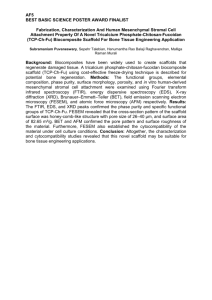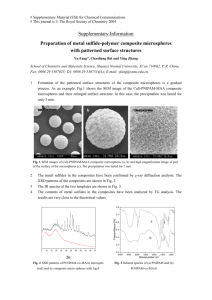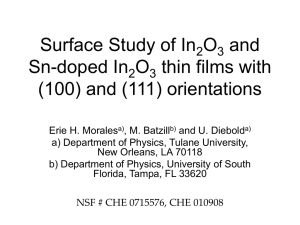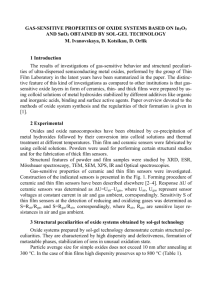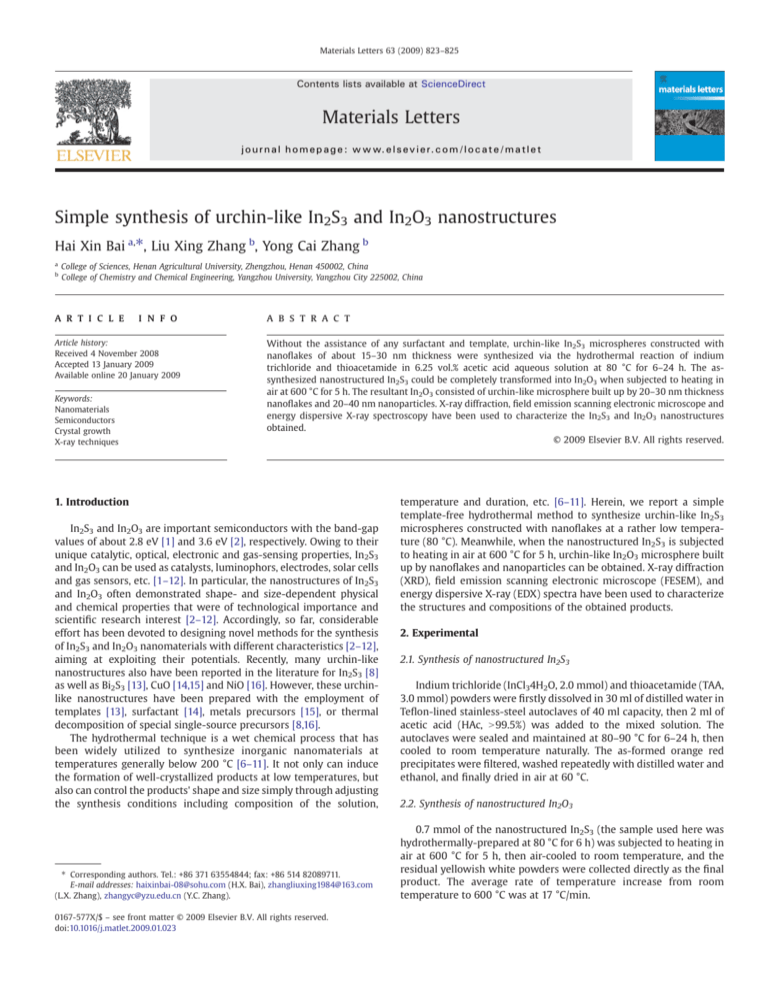
Materials Letters 63 (2009) 823–825
Contents lists available at ScienceDirect
Materials Letters
j o u r n a l h o m e p a g e : w w w. e l s ev i e r. c o m / l o c a t e / m a t l e t
Simple synthesis of urchin-like In2S3 and In2O3 nanostructures
Hai Xin Bai a,⁎, Liu Xing Zhang b, Yong Cai Zhang b
a
b
College of Sciences, Henan Agricultural University, Zhengzhou, Henan 450002, China
College of Chemistry and Chemical Engineering, Yangzhou University, Yangzhou City 225002, China
a r t i c l e
i n f o
Article history:
Received 4 November 2008
Accepted 13 January 2009
Available online 20 January 2009
Keywords:
Nanomaterials
Semiconductors
Crystal growth
X-ray techniques
a b s t r a c t
Without the assistance of any surfactant and template, urchin-like In2S3 microspheres constructed with
nanoflakes of about 15–30 nm thickness were synthesized via the hydrothermal reaction of indium
trichloride and thioacetamide in 6.25 vol.% acetic acid aqueous solution at 80 °C for 6–24 h. The assynthesized nanostructured In2S3 could be completely transformed into In2O3 when subjected to heating in
air at 600 °C for 5 h. The resultant In2O3 consisted of urchin-like microsphere built up by 20–30 nm thickness
nanoflakes and 20–40 nm nanoparticles. X-ray diffraction, field emission scanning electronic microscope and
energy dispersive X-ray spectroscopy have been used to characterize the In2S3 and In2O3 nanostructures
obtained.
© 2009 Elsevier B.V. All rights reserved.
1. Introduction
In2S3 and In2O3 are important semiconductors with the band-gap
values of about 2.8 eV [1] and 3.6 eV [2], respectively. Owing to their
unique catalytic, optical, electronic and gas-sensing properties, In2S3
and In2O3 can be used as catalysts, luminophors, electrodes, solar cells
and gas sensors, etc. [1–12]. In particular, the nanostructures of In2S3
and In2O3 often demonstrated shape- and size-dependent physical
and chemical properties that were of technological importance and
scientific research interest [2–12]. Accordingly, so far, considerable
effort has been devoted to designing novel methods for the synthesis
of In2S3 and In2O3 nanomaterials with different characteristics [2–12],
aiming at exploiting their potentials. Recently, many urchin-like
nanostructures also have been reported in the literature for In2S3 [8]
as well as Bi2S3 [13], CuO [14,15] and NiO [16]. However, these urchinlike nanostructures have been prepared with the employment of
templates [13], surfactant [14], metals precursors [15], or thermal
decomposition of special single-source precursors [8,16].
The hydrothermal technique is a wet chemical process that has
been widely utilized to synthesize inorganic nanomaterials at
temperatures generally below 200 °C [6–11]. It not only can induce
the formation of well-crystallized products at low temperatures, but
also can control the products' shape and size simply through adjusting
the synthesis conditions including composition of the solution,
⁎ Corresponding authors. Tel.: +86 371 63554844; fax: +86 514 82089711.
E-mail addresses: haixinbai-08@sohu.com (H.X. Bai), zhangliuxing1984@163.com
(L.X. Zhang), zhangyc@yzu.edu.cn (Y.C. Zhang).
0167-577X/$ – see front matter © 2009 Elsevier B.V. All rights reserved.
doi:10.1016/j.matlet.2009.01.023
temperature and duration, etc. [6–11]. Herein, we report a simple
template-free hydrothermal method to synthesize urchin-like In2S3
microspheres constructed with nanoflakes at a rather low temperature (80 °C). Meanwhile, when the nanostructured In2S3 is subjected
to heating in air at 600 °C for 5 h, urchin-like In2O3 microsphere built
up by nanoflakes and nanoparticles can be obtained. X-ray diffraction
(XRD), field emission scanning electronic microscope (FESEM), and
energy dispersive X-ray (EDX) spectra have been used to characterize
the structures and compositions of the obtained products.
2. Experimental
2.1. Synthesis of nanostructured In2S3
Indium trichloride (InCl34H2O, 2.0 mmol) and thioacetamide (TAA,
3.0 mmol) powders were firstly dissolved in 30 ml of distilled water in
Teflon-lined stainless-steel autoclaves of 40 ml capacity, then 2 ml of
acetic acid (HAc, N99.5%) was added to the mixed solution. The
autoclaves were sealed and maintained at 80–90 °C for 6–24 h, then
cooled to room temperature naturally. The as-formed orange red
precipitates were filtered, washed repeatedly with distilled water and
ethanol, and finally dried in air at 60 °C.
2.2. Synthesis of nanostructured In2O3
0.7 mmol of the nanostructured In2S3 (the sample used here was
hydrothermally-prepared at 80 °C for 6 h) was subjected to heating in
air at 600 °C for 5 h, then air-cooled to room temperature, and the
residual yellowish white powders were collected directly as the final
product. The average rate of temperature increase from room
temperature to 600 °C was at 17 °C/min.
824
H.X. Bai et al. / Materials Letters 63 (2009) 823–825
2.3. Characterization of the products
XRD patterns were measured on a German Bruker AXS D8 ADVANCE
X-ray diffractometer. FESEM images and EDX spectra were recorded on a
Japan Hitachi S-4800 FESEM equipped with an EDX attachment.
3. Results and discussion
Fig. 1. XRD patterns of the products derived from the hydrothermal reaction of
InCl34H2O and TAA in 6.25 vol.% HAc aqueous solution (a) at 90 °C for 6 h, or at 80 °C for
(b) 6 h, (c) 12 h and (d) 24 h; and (e) XRD pattern of the product obtained by heating the
nanostructured In2S3 in air at 600 °C for 5 h.
Fig. 1(a)–(d) show the XRD patterns of the products derived from the hydrothermal
reaction of InCl34H2O and TAA in 6.25 vol.% HAc aqueous solution at 80–90 °C for 6–
24 h. All the resultant products displayed the characteristic XRD peaks corresponding to
face-centered cubic structure In2S3, according to the JCPDS card no. 03-065-0459. No
XRD peaks arising from the possible impurities such as In2O3, InS, and other phases of
In2S3 were visible, suggesting the formation of pure cubic phase In2S3.
Fig. 2 shows the FESEM images of the In2S3 hydrothermally-prepared at 80 °C for 6,
12 and 24 h. It can be seen from Fig. 2(a), (b) and (c) that all the In2S3 products consisted
of mostly urchin-like microspheres with the diameters of about 1.8–3.7 µm. Based on
the observation of their magnified FESEM images in Fig. 2(d), (e) and (f), the urchin-like
microspheres were constructed with loosely and randomly arrayed nanoflakes of about
15–30 nm thickness. In addition, further increasing the reaction temperature to 150 °C
did not cause much change in the shape and microstructure of the resultant In2S3. The
origin for the formation of urchin-like In2S3 nanostructure may be related to intrinsic
anisotropy growth from ions solvated in aqueous solution and interaction of hydrogen
bonds.
Fig. 2. FESEM images of the In2S3 hydrothermally-synthesized at 80 °C for (a) 6 h, (b) 12 h and (c) 24 h; and (d), (e) and (f) are the higher magnification FESEM images of the products
in (a), (b) and (c).
H.X. Bai et al. / Materials Letters 63 (2009) 823–825
825
Fig. 3. EDX spectrum of the obtained In2O3.
When the above nanostructured In2S3 was heated in air at 600 °C for 5 h, cubic
phase In2O3 (JCPDS card no. 01-071-2194) could be obtained as shown by the XRD
pattern in Fig. 1(e). Besides, the EDX spectrum in Fig. 3 disclosed that this sample was
made of nearly stoichiometric In and O (the atomic ratio of In to O was estimated to be
40.65:59.35), without the contamination of S. Thus, both the XRD and EDX analysis
results indicated that the above nanostructured In2S3 had been completely transformed
into In2O3 when subjected to heating in air at 600 °C for 5 h.
The FESEM image of the obtained In2O3 in Fig. 4(a) showed that the product
comprised mostly urchin-like microspheres with the diameter of about 3–4.6 µm. From
the higher magnification FESEM image in Fig. 4(b), it can be seen that the urchin-like
microspheres are built up by loosely and randomly arrayed nanoflakes with the
thickness of about 20–30 nm as well as nanoparticles of about 20–40 nm. The similar
microstructure between In2O3 and its precursor may be understood by the shape
memory effect [17].
4. Conclusions
Urchin-like In2S3 microspheres constructed with nanoflakes were
synthesized by a hydrothermal process without surfactant and
template at 80 °C, and urchin-like In2O3 microspheres built up by
nanoflakes and nanoparticles were obtained by thermal oxidation of
the nanostructured In2S3 in air at 600 °C for 5 h. The present methods
are simple, mild and cheap, which make them suitable to be scaled up
for industrial production of multifunctional In 2 S 3 and In2 O 3
nanomaterials.
Acknowledgement
This work is supported by the project (No.30700348) sponsored by
the Scientific Research Foundation for the doctors in Henan
Agricultural University of China.
References
[1]
[2]
[3]
[4]
[5]
[6]
[7]
[8]
[9]
[10]
[11]
[12]
[13]
[14]
[15]
[16]
[17]
Fig. 4. (a) FESEM image and (b) higher magnification FESEM image of the obtained In2O3.
Puspitasari I, Gujar TP, Jung KD, Joo OS. J Mater Process Technol 2008;201:775–9.
Wang Q, Yu K, Xu F, Wu J. Mater Lett 2008;62:3217–9.
Xu J, Chen Y, Shen J. Mater Lett 2008;62:1363–5.
Datta A, Gorai S, Ganguli D, Chaudhuri S. Mater Chem Phys 2007;102:195–200.
Gorai S, Chaudhuri S. Mater Chem Phys 2005;89:332–5.
Datta A, Panda SK, Ganguli D, Mishra P, Chaudhuri S. Cryst Growth Des 2007;7:163–9.
Yu S, Shu L, Qian Y, Xie Y, Yang J. Mater Res Bull 1998;33:717–21.
Chen X, Zhang Z, Zhang X, Liu J, Qian Y. Chem Phys Lett 2005;407:482–6.
Yang J, Lin C, Wang Z, Lin J. Inorg Chem 2006;45:8973–9.
Chen LY, Zhang ZD, Wang WZ. J Phys Chem C 2008;112:4117–23.
Tang Q, Zhou W, Zhang W, Ou S, Qian Y. Cryst Growth Des 2005;5:147–50.
Liu Y, Xu H, Qian Y. Cryst Growth Des 2006;6:1304–7.
Huang X, Yang Y, Dou X, Zhu Y. J Alloys Compd 2008;461:427–31.
Keyson D, Volanti DP, Cavalcante LS, Simões AZ. Mater Res Bull 2008;43:771–5.
Vaseem M, Umar A, Kim SH, Al-Hajry A, Hahn YB. Mater Lett 2008;62:1659–62.
Bai L, Yuan F, Hu P, Yan S, Wang X, Li S. Mater Lett 2007;61:1698–700.
Yan L, Zhuang J, Sun X, Deng Z, Li Y. Mater Chem Phys 2002;76:119–22.

